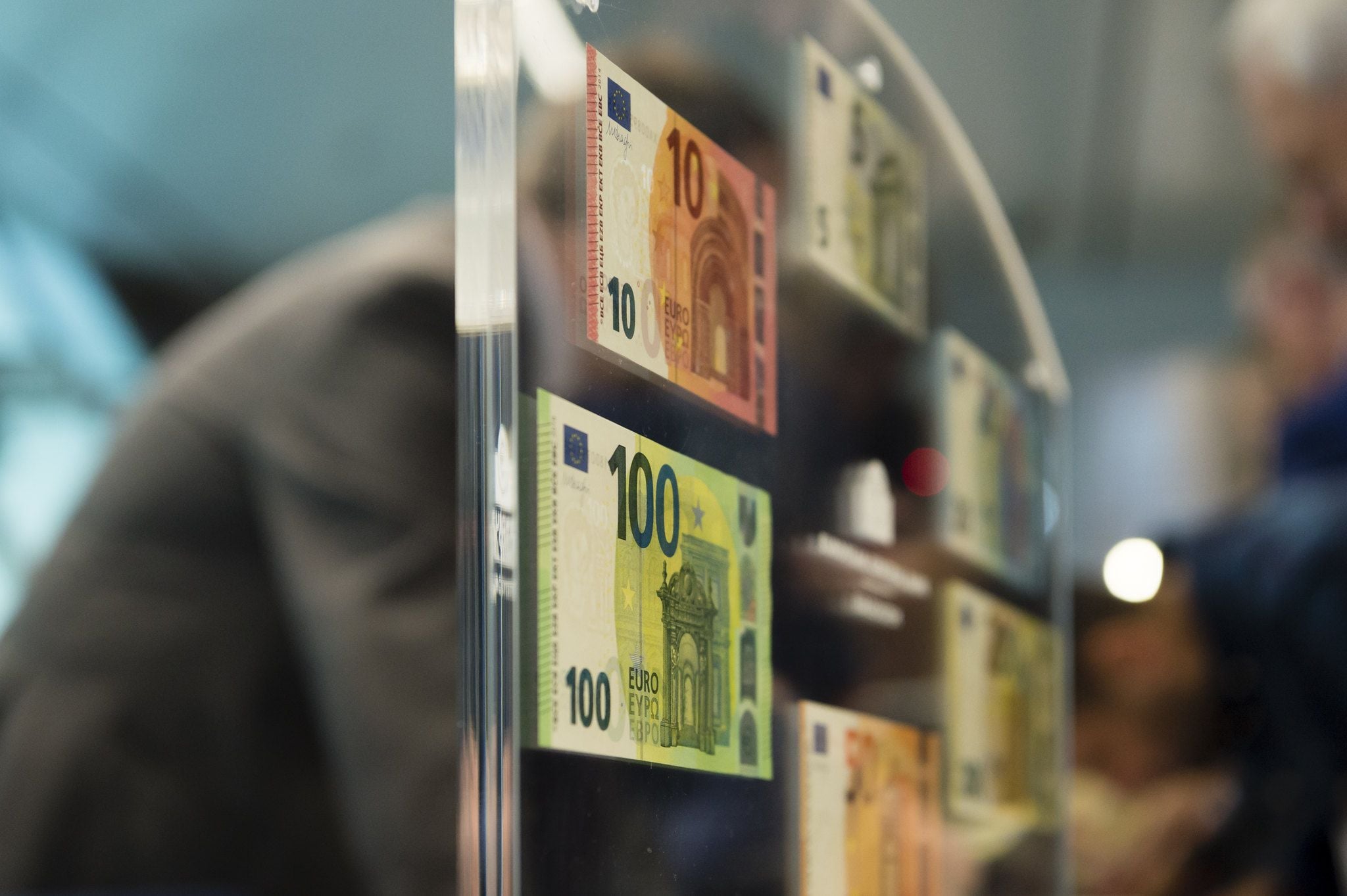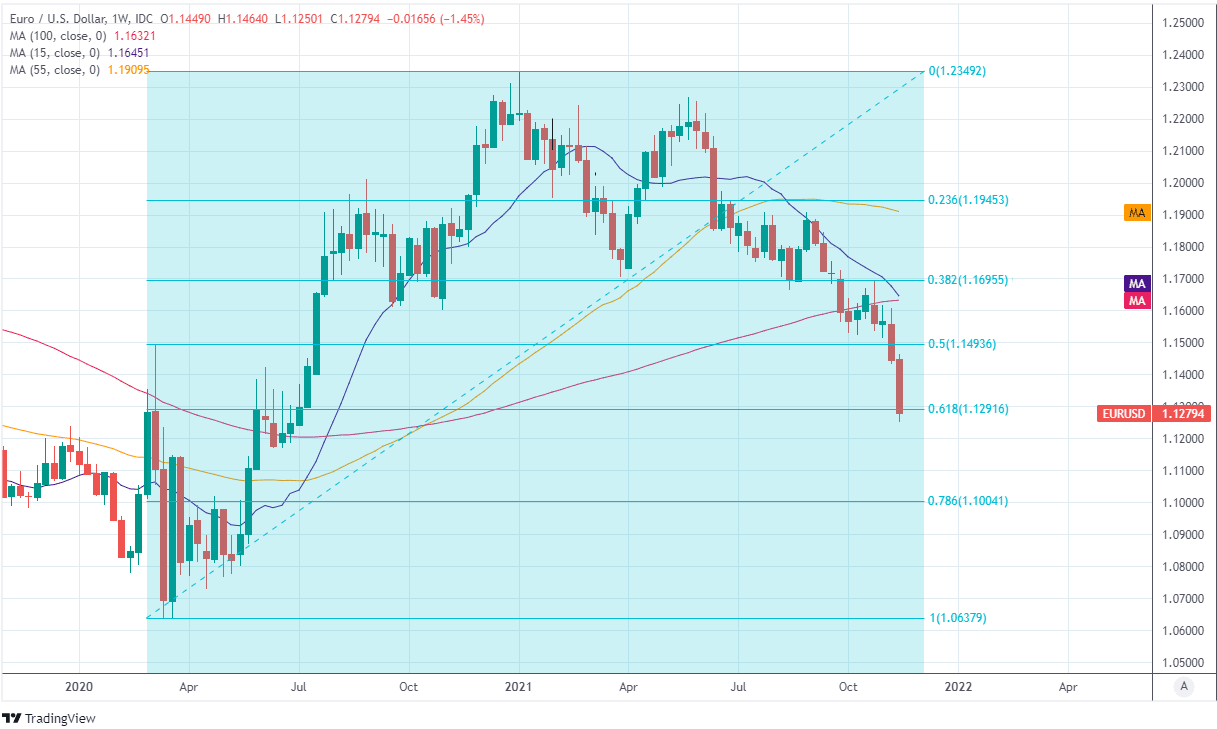Euro / Dollar Week Ahead Forecast: Downside Risks Persist
- Written by: James Skinner
-
- EUR/USD pressuring support at 1.1292, 1.1248
- Risks unravelling to 1.10 without a USD retreat
- New virus restrictions dim EZ economic outlook
- Reinforce expectations of ECB normalisation lag
- Leaves EUR at mercy of USD & Fed policy risks

Image © European Central Bank
The Euro to Dollar rate entered the new week in a position of vulnerability and at risk of further losses that could eventually see it trading as low as the 1.10 handle should the greenback remain on its front foot while European economies continue to lurch toward another winter of ‘lockdown.’
Europe’s single currency sustained its heaviest losses since early June and the days immediately after the Federal Reserve (Fed) first began to prepare markets for a steady withdrawal of the monetary stimulus provided to the U.S. economy since the onset of the coronavirus crisis.
Euro-Dollar traded as low as 1.1249 last week as the greenback advanced on all majors barring Sterling and the Renminbi while Europe’s single currency depreciated against all but its most risk sensitive regional counterparts.
“The combination of a very dovish ECB and now the possibility that economic activity is suppressed due to restrictions poses clear downside risks to the EUR toward 1.10/11. We continue to monitor developments on the energy front as delays in the approval of Nord Stream 2 are likely to keep energy costs elevated in the continent, and act as additional headwind,” says Juan Manuel Herrera, a strategist at Scotiabank.
Euro-Dollar losses built after Austria and the Netherlands each announced plans to return their countries and economies to a form of ‘lockdown’ in policy decisions came amid suggestions from German officials that they too could begin reintroducing restrictions in parts of the country over the coming days.
Above: Euro-Dollar rate shown at weekly intervals with Fibonacci retracements of 2020 recovery trend indicating likely areas of technical support.
- Reference rates at publication:
EUR to USD: 1.1264 - High street bank rates (indicative): 1.0870-1.0950
- Payment specialist rates (indicative: 1.1163-1.1208
- Find out about specialist rates, here
- Or, set up an exchange rate alert, here
The spectre of fresh economic closures has dimmed the Eurozone recovery outlook and will likely reinforce analyst and investor expectations for the European Central Bank (ECB) to lag behind major counterparts like the Fed and Bank of England (BoE) when it comes to normalising monetary policies.
“We note the 13 count on the daily chart and the divergence of the daily RSI and would allow for a near term rebound. Any bounces will find tough resistance at the 1.1630 5-month downtrend and while capped here, the overall bias is negative,” says Karen Jones, head of technical analysis for currencies, commodities and bonds at Commerzbank, writing in a Friday research presentation.
“Below 1.1248 (TD support) would target 1.10, the 78.6% retracement of the move seen in 2020,” Jones warned.
Losses led Euro-Dollar to break below an important technical support on the charts that is comprised of the 61.8% Fibonacci retracement of 2020’s recovery trend located at 1.1291, beneath which there is little other than the 1.1248 TD support to prevent the single currency sliding to 1.10.
The economic calendar for the week ahead is devoid of major data to guide the Euro other than the release of IHS Markit’s flash PMI surveys of the manufacturing and services sectors between 08:15 and 10:00 on Tuesday.
{wbamp-hide start}
{wbamp-hide end}{wbamp-show start}{wbamp-show end}
“Unless next week’s flash PMIs surprise significantly to the upside we would expect markets to remain focused on downside risks to Euro Area activity,” says Zach Pandl, co-head of global foreign exchange strategy at Goldman Sachs.
“We think EUR/USD can fall below current spot over a shorter horizon (~1m), but we would expect a rebound thereafter under our baseline forecasts for growth and policy on both sides of the Atlantic,” Pandl and colleagues wrote in a research note on Friday.
The Euro will likely watch European capitals closely this week for clues on the extent to which containment measures will be renewed on the continent, although the directional trend in the Dollar will also be an important factor while on Thursday and Friday attention is likely to turn to European Central Bank President Christine Lagarde who’s set to addresses the ECB Legal Conference 2021 twice before the weekend.
Market appetite for the Dollar will be PCE influenced by Wednesday’s releases of PCE inflation data and minutes from the November Fed meeting, which are due out at 15:00 GMT and 19:00 GMT in the middle of the week.
“On the heels of a blowout Oct CPI and a strong retail sales report Fed lift-off now priced in for July 2022, a marked shift from late Oct when markets priced just 10bp for July 2022,” says Richard Franulovich, head of FX strategy at Westpac.
Above: Euro-Dollar exchange rate shown at monthly intervals alongside EUR/GBP.
“EUR/USD rebounds are likely to be capped around 1.14 unless surveys prove to be notably strong. A break below 1.1250-75 could trigger another 2 figure decline,” Franulovich and colleagues wrote in a research briefing last week.
Financial markets have most recently begun to wager confidently that the Fed is likely to lift its interest rate as soon as June or July next year, with overnight-indexed-swap rate suggesting on Monday that it would raise the benchmark Fed Funds rate twice before the end of 2022.
That’s due to recent and ongoing developments around inflation and the U.S. labour market, which have lifted the Dollar sharply and weighed on the Euro, although the above assumptions could be called into question by investors this week if the White House decides to nominate a new candidate to lead the Fed from February next year.
The White House is expected to announce before Thanksgiving weekend whether incumbent Chairman Jerome Powell will be nominated for a second term if an alternative candidate will be put forward, and the outcome could impact market expectations for Fed policy.
“Recent client discussions have suggested that a surprise nomination of Lael Brainard, while not our central case, can upset the USD bulls,” says Valentin Marinov, head of FX strategy at Credit Agricole CIB, writing in a research note last week.
“It seems that many positives are already in the price of the USD. We further note that the Fed language has not changed all that much to justify the recent market moves. The increasingly overbought and overvalued USD can thus be vulnerable to potential more patient Fed guidance from here,” Credit Agricole’s Marinov also said last week.
Above: U.S. Dollar Index shown at weekly intervals with major moving-averages indicate possible areas of technical support while Fibonacci retracements of 2020 fall indicate likely areas of technical resistance.

